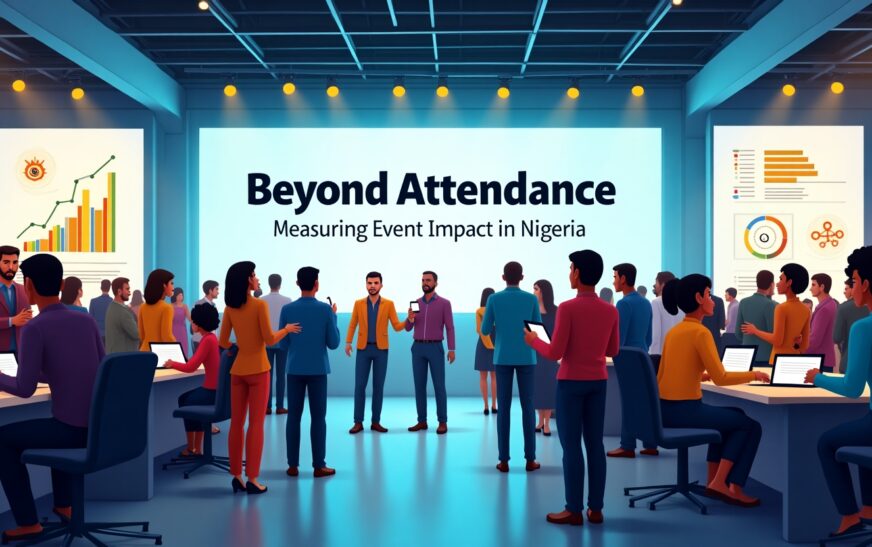Did you know that about 60% of events fail to meet their objectives due to poorly defined event goals? Setting event goals may look trivial, yet they are the foundation of the eventual successes of an event. Imagine setting out for a journey without knowing the destination. It will amount to a journey to nowhere. Would you want to be a ship that is going nowhere?
Among the several benefits of defining and achieving realistic event goals is the fact that without specific defined goals, it is challenging to determine what’s working and what requires tweaking or improvement. This could lead to waste of time and scarce resources. in other word measurable goals help yous to monitor and measure efficiently the progress made on the event project
In this article, you will learn how to set precise, quantifiable goals, match them with your customer’s expectations, and efficiently monitor your progress. In addition, if you are a newbie in the event business in Nigeria or somewhere else, you will learn how to focus, plan better and grow your business.
We get started now;
Step one:
Define the purpose of the event
The purpose of the event is the ‘why’ of the event. Never step out to start any event project without first determining the why of the event. Whether the event is for product promotion, brand awareness, mere celebration, reunion, networking, community involvement, et cetera, the why of the event is critical to designing and achieving a realistic event goal.
To define the purpose of any event, grab a paper, your mobile device or anything that helps you keep notes and ask the right questions. if you are assisting a customer with event planning or design, arrange a meeting or conference with them and make sure to ask the appropriate questions. A straightforward query such as “Why are we hosting this event?” can provide you with a number of the answers you seek.
Others may be. What is the vision of the company? What kind of experiences do you want your guest to gain? What motivated you to plan the event? How will you determine whether this event was a success?
Alternatively, you may ask for their concept note if they have one. It will help to summarise the proposal and event planning goals and give directions on requirements that may help you set up achievable event goals using the right event strategy.
Step two:
Engage a SMART GOAL Framework;
A SMART goal framework is a goal setting strategy discovered by Doran George.’ It only employs a series of acronyms—Specific, Measurable, Achievable, Relevant, and Time-bound—to precisely define and accomplish predetermined objectives.
For a clearer understanding of this framework, let me present it in a simple way by examining each concisely.
S – Specific: It simply means that the goal you want to achieve with the event must be specific in that it addresses in specific terms what the event is set to achieve. For example, if the event is to increase awareness of your brand, it must point out and set out with a specific percentage of awareness to be achieved compared to the previous one.
M – Measurable: This part of the framework explains that any goal you intend to set must have a metric that is quantifiable and countable so that you can measure progress. How many attendees, for instance, must be aware in order to show the success of the indicator?
A – Achievable: This part means that you have to set realistic goals that align with available resources, time, and capabilities within your reach and budget. For instance, how possible is it to achieve a 50% increase in awareness based on the budget, personnel and time that you have?
R-Relevant: This part of the framework ensures that goals align with the event’s overall purpose and the client’s vision
T – Timebound: Realistic event goals must be timebound; in other words, they must have a start date and an end date. For example, all awareness events must be within 3 months of the company’s operation.
Step Three:
Engage all stakeholders in the establishment of goals
No matter how professional you are, you may be on a lone ranger journey and on a wrong course without carrying your clients and all stakeholders along in defining the goal of the event. Planning an inclusive event will be necessary at this point. The insights of your clients, sponsors, vendors and even attendees are valuable. They assist in establishing realisable objectives, observing possible challenges, and opening up more chances for creativity.
Also, when everyone is in agreement, they realise their roles and responsibilities in achieving the objectives. It gives tham a sense of responsibility that further boost their acceptability and buy in.
Step Four:
Break down goals and make them actionable
It’s now time for action and less talk. This stage involves a structured approach that helps keep the planning process organised, ensures accountability, and allows for efficient management of time and resources.
Interestingly, this stage becomes easy because of the goals that have been defined already. The next step may now include setting up milestones or timelines for each deliverable that will be handled by specified persons.
In essence, it involves delegating specific tasks to vendors, team heads and other stakeholders as well as creating clear reporting lines, timetables, and data-sharing processes for effective communication, feedback, and monitoring to ensure everyone is kept informed.
Step Five:
Monitor progress
Monitoring progress is an extremely significant factor and step in achieving realistic event goals. It is an activity that tracks the performances of the KPIs. (Key Performance Index).
The KPIs are parameters formed from the agreed and set indicators in the earlier steps of the defined goals and the framework established previously. They become the index you track during this stage to ensure all your activities are leading to their attainment or not.
Curiously, there are technology tools that can aid in achieving outcomes that are nearly precise while also making this process smooth and simple. Some of the tools are a simple Excel sheet, Google Forms, event management apps, project management apps, etc. However, it is important to note that these tools should have been engaged from the beginning of the project so that it is able to track progress from the very beginning.
For instance, using the awareness metric we had established earlier, you can use a social media or event management tool to track the number of attendees that have been exposed to the awareness campaign and the number that are yet to.
Step Six:
Evaluate outcomes by comparing results with initially set goals
You might just be on your way to achieving realistic event goals by analysing the outcomes that you have achieved so far after a determined time of the project or event. Do this by comparing the event outcomes to the indicators in your SMART GOAL framework.
This process will help to see if you actually made progress or not. For instance , from the SMART GOAL framework, the specific intention was to increase the awareness of the brand by a certain percentage.
Step Seven:
Adjust, learn and grow
This whole process could seem rigorous, but it is worth the time and efforts you put into it. In essence, it is an event management process that has the potential to lead to an expected growth. Growing your business must be deliberate and the right steps taken.
What if, after the evaluations, you discovered that the set objectives were not realised? Hurray! You did not fail; you have only discovered a better way to get it right, allocate your resources better, set more realisable goals and keep scaling.
Flexibility and adaptability are very important virtues to possess at this stage. It is necessary for continuous learning and the needed mindset for growth. Ensure to document lessons learnt for references.
In conclusion, this article has taken you through critical pathways to setting and achieving realistic event goals. They will remain a mirage on paper until they are put to use. Try your hands on these steps for your next event and set your growth course.











